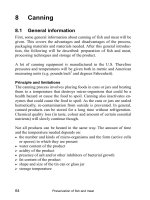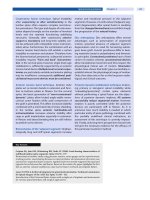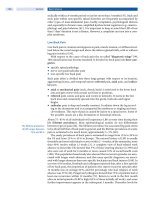Chapter 061. Disorders of Granulocytes and Monocytes (Part 8) pot
Bạn đang xem bản rút gọn của tài liệu. Xem và tải ngay bản đầy đủ của tài liệu tại đây (66.2 KB, 5 trang )
Chapter 061. Disorders of Granulocytes
and Monocytes
(Part 8)
Disorders of Adhesion
Two main types of leukocyte adhesion deficiency (LAD) have been
described, LAD 1 and LAD 2. Both are autosomal recessive traits and result in the
inability of neutrophils to exit the circulation to sites of infection, leading to
leukocytosis and increased susceptibility to infection (Fig. 61-8). Patients with
LAD 1 have mutations in CD18, the common component of the integrins LFA-1,
Mac-1, and p150,95, leading to a defect in tight adhesion between neutrophils and
the endothelium. The heterodimer formed by CD18/CD11b (Mac-1) is also the
receptor for the complement-derived opsonin C3bi (CR3). The CD18 gene is
located on distal chromosome 21q. The severity of the defect determines the
severity of clinical disease. Complete lack of expression of the leukocyte integrins
results in a severe phenotype in which inflammatory stimuli do not increase the
expression of leukocyte integrins on neutrophils or activated T and B cells.
Neutrophils (and monocytes) from patients with LAD 1 adhere poorly to
endothelial cells and protein-coated surfaces and exhibit defective spreading,
aggregation, and chemotaxis. Patients with LAD 1 have recurrent bacterial
infections involving the skin, oral and genital mucosa, and respiratory and
intestinal tracts; persistent leukocytosis (neutrophil counts of 15,000–20,000/µL)
because cells do not marginate; and, in severe cases, a history of delayed
separation of the umbilical stump. Infections, especially of the skin, may become
necrotic with progressively enlarging borders, slow healing, and development of
dysplastic scars. The most common bacteria are Staphylococcus aureus and
enteric gram-negative bacteria. LAD 2 is caused by an abnormality of fucosylation
of SLe
x
(CD15s), the ligand on neutrophils that interacts with selectins on
endothelial cells and is responsible for neutrophil rolling along the endothelium.
Infection susceptibility in LAD 2 appears to be less severe than in LAD 1. LAD 2
is also known as congenital disorder of glycosylation IIc (CDGIIc).
Disorders of Neutrophil Granules
The most common neutrophil defect is myeloperoxidase deficiency, a
primary granule defect inherited as an autosomal recessive trait; the incidence is
~1 in 2000 persons. Isolated myeloperoxidase deficiency is not associated with
clinically compromised defenses, presumably because other defense systems such
as hydrogen peroxide generation are amplified. Microbicidal activity of
neutrophils is delayed but not absent. Myeloperoxidase deficiency may make other
acquired host defense defects more serious. An acquired form of myeloperoxidase
deficiency occurs in myelomonocytic leukemia and acute myeloid leukemia.
Chédiak-Higashi syndrome (CHS) is a rare disease with autosomal
recessive inheritance due to defects in the lysosomal transport protein LYST,
encoded by the gene CHS1 at 1q42. This protein is required for normal packaging
and disbursement of granules. Neutrophils (and all cells containing lysosomes)
from patients with CHS characteristically have large granules (Fig. 61-9) making
it a systemic disease. Patients with CHS have nystagmus, partial oculocutaneous
albinism, and an increased number of infections resulting from many bacterial
agents. Some CHS patients develop an "accelerated phase" in childhood with a
hemophagocytic syndrome and an aggressive lymphoma requiring bone marrow
transplantation. CHS neutrophils and monocytes have impaired chemotaxis and
abnormal rates of microbial killing due to slow rates of fusion of the lysosomal
granules with phagosomes. NK cell function is also impaired. CHS patients may
develop a severe disabling peripheral neuropathy in adulthood that can lead to bed
confinement.
Figure 61-9
Chédiak-Higashi syndrome. The granulocytes contain huge cytoplasmic
granules formed from aggregation and fusion of azurophilic and specific granules.
Large abnormal granules are found in other granule-containing cells throughout
the body.
Specific granule deficiency is a rare autosomal recessive disease in which
the production of secondary granules and their contents, as well as the primary
granule component defensins, is defective. The defect in bacterial killing leads to
severe bacterial infections. One type of specific granule deficiency is due to a
mutation in the CCAAT/enhancer binding protein-ε, a regulator of expression of
granule components.









